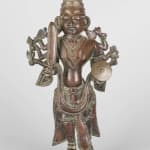Bronze figurine of the Indian deity Vishnu
Bronze
CB.3188
Further images
Vishnu is one of the principal deities of Hinduism, and the Supreme Being in its Vaishnavism tradition. Vishnu is the 'preserver' in the Hindu trinity (Trimurti) that includes Brahma and...
Vishnu is one of the principal deities of Hinduism, and the Supreme Being in its Vaishnavism tradition. Vishnu is the "preserver" in the Hindu trinity (Trimurti) that includes Brahma and Shiva.
Vishnu iconography show him with a dark blue, blue-gray or black colored skin, and as a well dressed jeweled man. He is typically shown with four arms. The historic identifiers of his icon include his image holding a conch shell between first two fingers of one hand (left back), a chakra – war discus – in another (right back). The conch shell is spiral and symbolizes all of interconnected spiraling cyclic existence, while the discus symbolizes him as that which restores dharma with war if necessary when cosmic equilibrium is overwhelmed by evil. One of his arms sometimes carries a gadda (club, mace) which symbolizes authority and power of knowledge.
In the fourth arm, he holds a lotus flower which symbolizes purity and transcendence.
The items he holds in various hands varies, giving rise to twenty four combinations of iconography, each combination representing a special form of Vishnu. Each of these special forms is given a special name in texts such as the Agni Purana and Padma Purana. These texts, however, are inconsistent.Vishnu iconography show him either in standing pose, seated in a yoga pose, or reclining. Hindu texts on iconography describe design rules of these.
Vishnu iconography show him with a dark blue, blue-gray or black colored skin, and as a well dressed jeweled man. He is typically shown with four arms. The historic identifiers of his icon include his image holding a conch shell between first two fingers of one hand (left back), a chakra – war discus – in another (right back). The conch shell is spiral and symbolizes all of interconnected spiraling cyclic existence, while the discus symbolizes him as that which restores dharma with war if necessary when cosmic equilibrium is overwhelmed by evil. One of his arms sometimes carries a gadda (club, mace) which symbolizes authority and power of knowledge.
In the fourth arm, he holds a lotus flower which symbolizes purity and transcendence.
The items he holds in various hands varies, giving rise to twenty four combinations of iconography, each combination representing a special form of Vishnu. Each of these special forms is given a special name in texts such as the Agni Purana and Padma Purana. These texts, however, are inconsistent.Vishnu iconography show him either in standing pose, seated in a yoga pose, or reclining. Hindu texts on iconography describe design rules of these.







